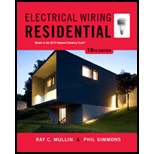
Electrical Wiring Residential
18th Edition
ISBN: 9781285170954
Author: Ray C. Mullin, Phil Simmons
Publisher: Cengage Learning
expand_more
expand_more
format_list_bulleted
Concept explainers
Question
Chapter 9, Problem 26R
To determine
List the locations to install outlet boxes in homes, in order to support a ceiling-suspended (paddle) fan.
Expert Solution & Answer
Trending nowThis is a popular solution!

Students have asked these similar questions
Find the valve of voltage Vx using SUPERPOSITION
1 M
FA
www
4
5
M
MAA
12V
-
$10
33
M
23
+x
mn
6
8A
Find the Valve of Voltage Vy using SUPERPOSITION
الله
8
ZV
ДАДА
6
5
ча
4
w
3
1
mm
2A
MW
Find the value of voltage
Using SUPER POSITION.
GV
www
6
M
33
ww
ЧА
5.
123
AM
4
4
۱۹۷
Chapter 9 Solutions
Electrical Wiring Residential
Ch. 9 - What circuit supplies the Master Bedroom?Ch. 9 - What unique type of electrical protection is...Ch. 9 - Prob. 4RCh. 9 - Prob. 5RCh. 9 - Prob. 6RCh. 9 - What is the estimated load in volt-amperes for the...Ch. 9 - Prob. 8RCh. 9 - How many conductors enter the ceiling fan/light...Ch. 9 - What type and size of box may be used for the...Ch. 9 - Prob. 11R
Ch. 9 - a. Does the circuit for the Master Bedroom have a...Ch. 9 - Approximately how many feet (meters) of 2-wire...Ch. 9 - If the cable is laid in notches in the corner...Ch. 9 - Prob. 15RCh. 9 - Prob. 16RCh. 9 - Prob. 17RCh. 9 - Prob. 18RCh. 9 - Prob. 19RCh. 9 - Show your calculations of how to select a proper...Ch. 9 - Prob. 21RCh. 9 - The following is a layout of the lighting circuit...Ch. 9 - Prob. 23RCh. 9 - Prob. 24RCh. 9 - May a standard electronic dimmer be used to...Ch. 9 - Prob. 26R
Knowledge Booster
Learn more about
Need a deep-dive on the concept behind this application? Look no further. Learn more about this topic, electrical-engineering and related others by exploring similar questions and additional content below.Similar questions
- Please explain in detail. I am most confused on how to get the transfer functions. thank youarrow_forwardPlease explain step by step in detail. I am most confused about the table. Thank youarrow_forwardUsing the block diagram or solution, show that the expected gain in the transfer function CA' (s)/Q'(s) is negative. Please explain how to approach this. No typed answers where the equation is in one line and it's hard to understand, please дома dela 1 C_AO G2(s) G3(5) dCA(t) dt dT' (t) dt = 2 Q beta 3-a G1(s) G4(s) (-AHko E koe RT + EKOČA RT2 E e E F T' (t) + Co (t) E 1 (All) (- -)+(y) = pcp eRT CA(t) + Е КОСАДНЕ PCPRT2 eRT T'(t) + Q'(t) 2 Tarrow_forward
- can you please answerarrow_forwardThe line diagram is of a standard forward/reverse/stop pushbutton station for forwarding and reversing a motor. Included in the circuit are mechanical and auxiliary contact interlocking. Also included are a forward overtravel limit switch to stop the motor in forward and a reverse overtravel limit switch to stop the motor in reverse. Overload protection is common to both forward and reverse directions. Complete the wiring diagram based on the line diagram. Do not make any wire splices or additional terminal connections on the wiring diagram (notice how they make multiple connections in the power circuit). All connections must run from terminal screw to terminal screw complete the wiring diagram based on the line diagram. Do not make any wires splices or additional terminal connections on the wiring diagram. All connections must run from terminal screw to terminal screwarrow_forward6.7 Consider a baseband binary PAM system that transmits at 3600 bps with a bit error rate less than 10-4. The channel introduces no distortion, but attenuates the signal by 20 dB and has a bandwidth of 2.4 kHz. The channel noise is AWGN with a power spectral density of 10-14 watts per Hertz (W/Hz). Design the optimum transmitting and receiving filters, and determine the required transmit power.arrow_forward
arrow_back_ios
SEE MORE QUESTIONS
arrow_forward_ios
Recommended textbooks for you
 EBK ELECTRICAL WIRING RESIDENTIALElectrical EngineeringISBN:9781337516549Author:SimmonsPublisher:CENGAGE LEARNING - CONSIGNMENT
EBK ELECTRICAL WIRING RESIDENTIALElectrical EngineeringISBN:9781337516549Author:SimmonsPublisher:CENGAGE LEARNING - CONSIGNMENT

EBK ELECTRICAL WIRING RESIDENTIAL
Electrical Engineering
ISBN:9781337516549
Author:Simmons
Publisher:CENGAGE LEARNING - CONSIGNMENT